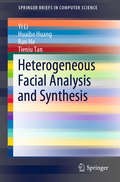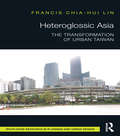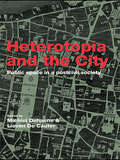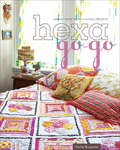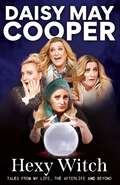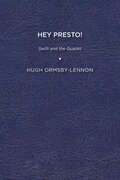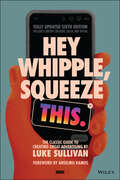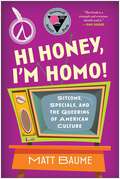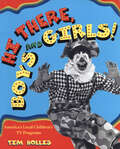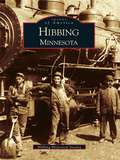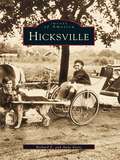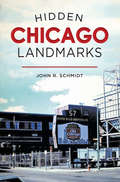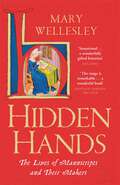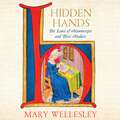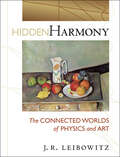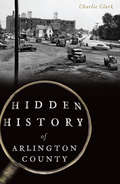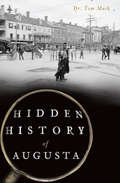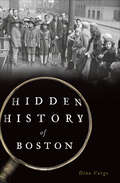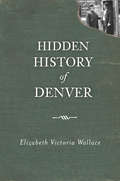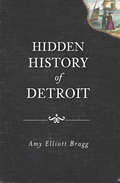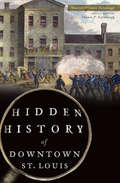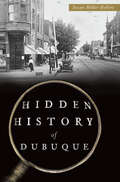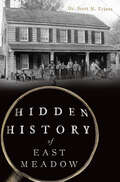- Table View
- List View
Heterogeneous Facial Analysis and Synthesis (SpringerBriefs in Computer Science)
by Yi Li Ran He Tieniu Tan Huaibo HuangThis book presents a comprehensive review of heterogeneous face analysis and synthesis, ranging from the theoretical and technical foundations to various hot and emerging applications, such as cosmetic transfer, cross-spectral hallucination and face rotation. Deep generative models have been at the forefront of research on artificial intelligence in recent years and have enhanced many heterogeneous face analysis tasks. Not only has there been a constantly growing flow of related research papers, but there have also been substantial advances in real-world applications. Bringing these together, this book describes both the fundamentals and applications of heterogeneous face analysis and synthesis. Moreover, it discusses the strengths and weaknesses of related methods and outlines future trends. Offering a rich blend of theory and practice, the book represents a valuable resource for students, researchers and practitioners who need to construct face analysis systems with deep generative networks.
Heteroglossic Asia: The Transformation of Urban Taiwan
by Francis Chia-Hui LinHeteroglossic Asia presents an analysis of geographic, historical, cultural, economic, spatial and political factors underlying Taiwan’s maritime urbanity by means of case studies based on Taipei and Kaohsiung; two cities which represent the multi-accentual character of Taiwan’s urban environment and its recent changes and development through architecture. Focussing on the concept of a heteroglossic Asia Pacific, exemplified by the analysis of Taiwan’s urban transformation, the study argues that Taiwan’s urban environment shows a form of intended "fuzziness" which cannot be described as resting on either a simplified nationalist base or chaotic societal anxiety. Rather, this form lies between binary poles: autocracy and democracy, nation state and day-to-day life, top-down and bottom-up orientations, orthodoxy and hybridisation.
Heterotopia and the City: Public Space in a Postcivil Society
by Michiel Dehaene Lieven De CauterHeterotopia, literally meaning ‘other place’, is a rich concept in urban design that describes a space that is on the margins of ordered or civil society, and one that possesses multiple, fragmented or even incompatible meanings. The term has had an impact on architectural and urban theory since it was coined by Foucault in the late 1960s but it has remained a source of confusion and debate since. Heterotopia and the City seeks to clarify this concept and investigates the heterotopias which exist throughout our contemporary world: in museums, theme parks, malls, holiday resorts, gated communities, wellness hotels and festival markets. With theoretical contributions on the concept of heterotopia, including a new translation of Foucault’s influential 1967 text, Of Other Space and essays by well-known scholars, the book comprises a series of critical case studies, from Beaubourg to Bilbao, which probe a range of (post)urban transformations and which redirect the debate on the privatization of public space. Wastelands and terrains vagues are studied in detail in a section on urban activism and transgression and the reader gets a glimpse of the extremes of our dualized, postcivil condition through case studies on Jakarta, Dubai, and Kinshasa. Heterotopia and the City provides a collective effort to reposition heterotopia as a crucial concept for contemporary urban theory. The book will be of interest to all those wishing to understand the city in the emerging postcivil society and post-historical era. Planners, architects, cultural theorists, urbanists and academics will find this a valuable contribution to current critical argument.
Hexa-Go-Go: English Paper Piecing
by Tacha Bruecher“The modern quilt movement is at its best when it finds creative ways to make classic techniques fit in with modern tastes. Bruecher has done just that.” —Library JournalFat QuarterlyMagazine cofounder Tacha Bruecher takes a fresh look at an old favorite—English paper-pieced hexagons—with current fabrics and settings for quilts, table toppers, and more. Modern and traditional designs are both featured, including rosettes, stars, and free form. Learn how to combine settings and how to creatively quilt hexagons. Projects are varied for any skill level or time commitment—make a few hexagons, make a few more, or make few hundred. Making the individual hexagons is perfect for modern quilters on the go; the process is a terrific stash buster (and stress buster) that takes your priceless handwork from repetitive to remarkable!“Tacha is an amazing quilter and crafter, and both her style and skill are presented beautifully in this book. Tacha is one of those talented crafters whose fabric choices and original patterns reflect the eye of a modern quilter, but who simultaneously pays homage to the history and traditions of quilting. The result is a beautiful book that is sure to become a classic!” —quiltdad.com“What makes Tacha’s book different and worth buying is that she has added a modern twist—with wonky piecing, white sashing, embroidery, raw-edge applique and a color palette and fabric choices that scream ‘modern.’” —Australian Homespun Magazine
Hexie Garden Quilt: 9 Whimsical Hexagon Blocks to Appliqué & Piece
by Becky GoldsmithJoin the Piece O' Cake block-of-the-month Appliqué hexagons using stunning, floral designs with this block-of-the-month pattern pack from Becky Goldsmith of Piece O' Cake Designs. This take-along sewing project includes 9 appliqué blooms that complement each other yet shine on their own in single-block projects. Individual templates for each appliqué shape make prep work fast and easy. Graphic, fast, and full of movement, these easy-to-piece wedge blocks are appealing to both traditional and modern quilters. Show off your favorite motif in Tequila Sunrise, a bonus one-block project. - Enjoy slow sewing with 9 floral appliqué hexie blocks that blend traditional and modern sensibilities - Stitch a block each month, joining geometric wedges with hexie flower details - Free bonus pattern! Design a mini quilt with style - From best-selling author Becky Goldsmith
Hexy Witch: Tales from My Life, the Afterlife, and Beyond
by Daisy May CooperFollowing her 2021 bestselling memoir Don't Laugh, It'll Only Encourage Her comes the laugh out loud follow-up Hexy Witch. 'My life's changed a lot since This Country came out. Among all the amazing times there have been some stranger ones: the time a man climbed the wall into my garden and curled one out on the lawn while staring me dead in the eyes. Or that time I was visited by a pair of legs running around my bedroom as I watched Paw Patrol with my son. And I will never ever forget joining a coven, regressing to a past life, and attempting to have sex with a ghost.I know that talking about this stuff still feels very taboo. If you say you are a believer in certain circles it's like announcing to a meeting of the Women's Institute that you masturbate. Or dropping the C-bomb in front of a parish priest. But for as long as I can remember I've been fascinated by the unexplained. I've explored haunted houses, interrogated experts who claim they can communicate with the other side, and investigated paganism, which turned out to be a front for swinging. Things have always cracked me up but they're about to get HEXY.*The title of the digital edition has been changed from its original publication.
Hexy Witch: Tales from My Life, the Afterlife, and Beyond
by Daisy May CooperFollowing her 2021 bestselling memoir Don't Laugh, It'll Only Encourage Her comes the laugh out loud follow-up Hexy Witch. 'My life's changed a lot since This Country came out. Among all the amazing times there have been some stranger ones: the time a man climbed the wall into my garden and curled one out on the lawn while staring me dead in the eyes. Or that time I was visited by a pair of legs running around my bedroom as I watched Paw Patrol with my son. And I will never ever forget joining a coven, regressing to a past life, and attempting to have sex with a ghost.I know that talking about this stuff still feels very taboo. If you say you are a believer in certain circles it's like announcing to a meeting of the Women's Institute that you masturbate. Or dropping the C-bomb in front of a parish priest. But for as long as I can remember I've been fascinated by the unexplained. I've explored haunted houses, interrogated experts who claim they can communicate with the other side, and investigated paganism, which turned out to be a front for swinging. Things have always cracked me up but they're about to get HEXY.*The title of the digital edition has been changed from its original publication.
Hey Presto!: Swift and the Quacks
by Hugh Ormsby-LennonIn this book the author reveals how medicine shows, both ancient and modern, galvanized Jonathan Swift’s imagination and inspired his wittiest satiric voices. Swift dubbed these multifaceted traveling entertainments his Stage-itinerant or “Mountebank’s Stage.” In the course of arguing that the stage-itinerant formed an irresistible model for A Tale of a Tub, Ormsby-Lennon also surmises that the mountebank’s stage will disclose that missing link, long sought, which connects the twin objects of Swift’s ire: gross corruptions in both religion and learning. In the early modern medicine show, the quack doctor delivered a loquacious harangue, infused with magico-mysticism and pseudoscience, high-astounding promises, and boastful narcissism. To help him sell his panaceas and snake-oil, he employed a Merry Andrew and a motley troupe of performers. From their stages, many quacks also peddled their own books, almanacs, and other ephemera, providing Grub Street with many of its best-sellers. Hacks practiced, quite literally, as quacks. Merry Andrew and mountebank traded costumes, whiskers, and voices. Swift apes them all in the Tale. Published by University of Delaware Press. Distributed worldwide by Rutgers University Press.
Hey Whipple, Squeeze This: The Classic Guide to Creating Great Advertising
by Luke SullivanThe new edition of the book readers call the bible for advertising The sixth edition of Hey Whipple, Squeeze This offers a new take on the rapidly evolving industry of creative advertising. Creativity—while critical—is no longer enough to succeed. Updating all the classic creativity training from the first five editions, this updated version now provides the necessary tools to navigate the field’s changing technical and social media landscapes. From learning how to tell brand stories to creating content for Instagram, YouTube, and TikTok, Whipple will help sharpen your writing chops, enhance your creativity, and raise the level of your work whether you’re new to the business or a practicing professional. In this fully updated edition, you’ll explore: How to employ the traditional concepting techniques today’s creatives use, as well as new developments in applied creativity and inquiry-based innovation. How to use emerging technologies and the different technical structures of social media platforms to bring brand stories to life. How to go 180˚ against common sense for ideas that have the potential of becoming viral. How to create the kind of portfolio that will get you a job in the industry.
Hi Honey, I'm Homo!: Sitcoms, Specials, and the Queering of American Culture
by Matt BaumeLambda Literary Award Winner for LGBTQ+ Nonfiction 2024 Stonewall Book Honor Award Winner—Israel Fishman Non-Fiction Book Award Featured on NPR's Books We Love 2023 One of Vulture's Best Comedy Books of 2023 "This book is a triumph and everyone should read it." —Dan Savage, journalist and author, on the "Savage Lovecast" "Hi Honey, I&’m Homo is a heartbreaking historical document, but ultimately one that will leave the reader feeling proud of how something as maligned and disposable as the network sitcom used comedy to bring about such profound and important social progress." —Vulture "[A] well-curated compendium of prime time broadcasting . . . Baume is a companionable guide." —Shelf Awareness Behind the scenes of the most popular sitcoms of the 20th century, a revolution was brewing. For decades, amidst the bright lights, studio-audience laughs, and absurdly large apartment sets, the real-life story of American LGBTQ+ liberation unfolded in plain sight in front of millions of viewers, most of whom were laughing too hard to mind. From flamboyant relatives on Bewitched to closely-guarded secrets on All in the Family, from network-censor fights over Soap to behind-the-scenes activism on the set of The Golden Girls, from Ellen&’s culture clash and Will & Grace&’s mixed reception to Modern Family&’s primetime power-couple, Hi Honey, I&’m Homo! is the story not only of how subversive queer comedy transformed the American sitcom, from its inception through today, but how our favorite sitcoms transformed, and continue to transform, America. Accessible, entertaining, and informative, Hi Honey, I&’m Homo! features commentary and interviews from celebrities, behind-the-scenes creators, and more.
Hi There, Boys and Girls!: America's Local Children's TV Programs
by Tim HollisWhatever happened to Bozo the Clown, to Aunt Norma, to Solomon C. Whiskers, those television celebrities who hammed it up between cartoons and contests during local kids' shows? In Hi There, Boys and Girls! America's Local Children's TV Programs, Tim Hollis tracks down the story of every known local children's TV show from markets across the United States. There have been many books about children's television on the networks, and such shows as Captain Kangaroo, Howdy Doody, and Sesame Street are legends in broadcasting. However, the local branch of children's programming has received much less attention. For every performer on the scale of a Captain Kangaroo or a Buffalo Bob, there were five or six local personalities who were just as beloved by their viewers--and sometimes even more so--since these local stars could be counted on for appearances at stores, children's hospitals, and shopping centers, where kids could meet them face-to-face. Anyone over the age of thirty who grew up with a TV set will remember at least one or two of these productions. Whether it was hosted by a cowboy character, a clown such as the one on the many-franchised Bozo shows, a policeman, a sea captain who showed Popeye cartoons, or one of the gentle and lovely ladies who presided over Romper Room, these hometown stars were some of the Baby Boomers' first friends. Although children loved them, these hard-working performers garnered less respect from the rest of the TV industry. Hi There, Boys and Girls! includes a capsule history of this programming from the earliest days of radio to the early 1970s, when a combination of social changes and broadcast regulations sent most of the hosts into retirement. Walt Disney once observed that while there is very little adult in a child, there is a lot of child in every adult. This book will bring back a flood of long-submerged memories for anyone who was a child during this golden era.
Hibbing, Minnesota
by Hibbing Historical SocietySurrounded by large stands of virgin white and red pines, an enterprising iron prospector named Frank Hibbing set up camp on a bitterly cold day in January of 1892. When he awoke the next day, he insisted that there was iron beneath him-he could "feel it in his bones." He staked his claim near that campsite, and after digging several test pits, one of the world's richest deposits of iron ore was found.Beginning as a small collection of tents and log cabins, the Village of Hibbing was incorporated in August of 1893. It became one of the largest of the mining towns along the Mesabi Range, attracting immigrants of many backgrounds such as Finnish, Italian, Slavic, Swedish, and Greek. This mixture of diverse backgrounds gave Hibbing a unique culture that remains evident today. From Minnesota's famous dual in 1910 between friends Sam Kacich and Pete Radovich, to the relocation of the entire village in the 1920s, Hibbing, Minnesota takes us back in time to the days of pioneers, horse-drawn carriages, and a love of the land that has been passed on from generation to generation.
Hicksville
by Anne Evers Richard E. EversWith Hicksville, local historians Richard and Anne Evers take us on a journey back in time from the area's 1648 land purchase from Native Americans and associations with Elias Hicks, the Jericho antislavery leader, to its transformation into a thriving twentieth-century Long Island suburb of New York City. Through evocative images and insightful text, we learn how the Long Island Railroad was dead-ended here in the Panic of 1837 and how German immigrants created a village and vacation spa in the area. Readers fly with the Lone Eagle as he coaches his wife, Anne Morrow Lindbergh, to make good landings at the Long Island Aviation Country Club. We glimpse singer and songwriter Billy Joel learning his craft as a young Hicksville piano man. At General Instrument we watch as workers win a Navy E award for developing technology to guide the Polaris missiles on our Cold War submarines. Home to goldbeaters, a Heinz pickle works, the famous Long Island potato, and epoch-making Levitt-type homes near Grumman's (whose naval aircraft won the Pacific War), Hicksville has made large contributions to the nation's social, economic, and political sectors.
Hidden Chicago Landmarks (Hidden History)
by John R. SchmidtTake in the sights of Chicago's forgotten byways, including a cow trail through a downtown hotel. Pause reflectively at the cemetery in a working scrapyard and the church built without a nail. Stop by the one-time homes of Walt Disney, Joe Louis, Hillary Clinton and Al Capone. Along the way, greet forgotten Chicago notables like the vice president who won a Nobel Prize and wrote a number-one pop hit. From the shortest street to the oldest house, John R. Schmidt visits the sites of Chicago's neglected history.
Hidden Hands: The Lives of Manuscripts and Their Makers
by Mary WellesleyManuscripts teem with life. They are not only the stuff of history and literature, but they offer some of the only tangible evidence we have of entire lives, long receded. Hidden Hands tells the stories of the artisans, artists, scribes and readers, patrons and collectors who made and kept the beautiful, fragile objects that have survived the ravages of fire, water and deliberate destruction to form a picture of both English culture and the wider European culture of which it is part.Without manuscripts, she shows, many historical figures would be lost to us, as well as those of lower social status, women and people of colour, their stories erased, and the remnants of their labours destroyed.From the Cuthbert Bible, to works including those by the Beowulf poet, Margery Kempe, Julian of Norwich, Sir Thomas Malory, Chaucer, the Paston Letters and Shakespeare, Mary Wellesley describes the production and preservation of these priceless objects. With an insistent emphasis on the early role of women as authors and artists and illustrated with over fifty colour plates, Hidden Hands is an important contribution to our understanding of literature and history.
Hidden Hands: The Lives of Manuscripts and Their Makers
by Mary WellesleyManuscripts teem with life. They are not only the stuff of history and literature, but they offer some of the only tangible evidence we have of entire lives, long receded. Hidden Hands tells the stories of the artisans, artists, scribes and readers, patrons and collectors who made and kept the beautiful, fragile objects that have survived the ravages of fire, water and deliberate destruction to form a picture of both English culture and the wider European culture of which it is part.Without manuscripts, she shows, many historical figures would be lost to us, as well as those of lower social status, women and people of colour, their stories erased, and the remnants of their labours destroyed.From the Cuthbert Bible, to works including those by the Beowulf poet, Margery Kempe, Julian of Norwich, Sir Thomas Malory, Chaucer, the Paston Letters and Shakespeare, Mary Wellesley describes the production and preservation of these priceless objects. With an insistent emphasis on the early role of women as authors and artists, Hidden Hands is an important contribution to our understanding of literature and history.(P) 2021 Quercus Editions Limited
Hidden Harmony: The Connected Worlds of Physics and Art
by Jack R. LeibowitzMost "art and science" books focus on the science of perspective or the psychology of perception. Hidden Harmony does not. Instead, the book addresses the surprising common ground between physics and art from a novel and personal perspective. Viewing the two disciplines as creative processes, J.R. Leibowitz supplements existing and original research with illustrations to demonstrate that physics and art share guiding aesthetics and compositional demands and to show how each speaks meaningfully to the other. Hidden Harmony is the first serious look at what art and physics, as creative processes, have in common. Without assuming a background either in art or physics, the author widens our experience and understanding of both domains by exploring how concepts such as balance and re-balance, coherence and unity, and symmetry and broken symmetry affect and are affected by artistic vision and scientific principle. He reveals shared themes and understandings in each field and adroitly illustrates the parallels between the strategies guiding the dabs of color and layers of images in a work of art and those guiding the assembly of physical evidence into models of the physical world. Featuring examples of paintings and sculptures and complementary examples of physical concepts, this contemplative work helps us see art and physics as artists and physicists do.
Hidden History of Arlington County (Hidden History)
by Charlie ClarkArlington County, for two centuries a center for government institutions, is a vibrant part of the Washington, D.C., community. Many notable figures made their home in the area, like Supreme Court chief justice Warren Burger, General George “Blood ’n’ Guts” Patton and a beauty queen who almost married crooner Dean Martin. The drama of Virginia’s first school integration unfolded in Arlington beginning in the late 1950s. In the 1960s, two motorcycle gangs clashed in public at a suburban shopping center. Local author, historian and “Our Man in Arlington” Charlie Clark uncovers the vivid, and hidden, history of a capital community.
Hidden History of Augusta (Hidden History)
by Dr Tom MackSituated along the Georgia border, Augusta is known for its golf, beautiful private gardens and southern culture. But its history is also brimming with strange stories yet to be told. A beleaguered German princess gave the city its name. A "haunted pillar" survived a tornado that destroyed the area in 1878. The famous Wright brothers opened a branch of their flying school here in 1911. Author and historian Tom Mack uncovers and celebrates these gems hidden in Augusta's rich and teeming history.
Hidden History of Boston: History Through Architecture (Hidden History)
by Dina VargoQuirky and little-known true stories of one of America&’s most historic cities. Boston may play a big role in American history textbooks, but it also has quite a bit of forgotten past. For example, during the colonial era, riotous mobs celebrated their hatred of the pope in an annual celebration called Pope&’s Night. In 1659, Christmas was made illegal, a ban by the Puritans that remained in effect for twenty-two years. William Monroe Trotter published the Boston Guardian, an independent African American newspaper, and was a beacon of civil rights activism at the turn of the century. And in more recent times, a centuries-long turf war played out on the streets of quiet Chinatown, ending in the massacre of five men in a back alley in 1991. Author and historian Dina Vargo shines a light into the cobwebbed corners of Boston&’s hidden history in this riveting read, complete with illustrations.
Hidden History of Denver (Hidden History)
by Elizabeth Victoria WallaceWhen prospectors set up camp on Cherry Creek in 1858, Denver emerged as a lightning rod for the extraordinary. Time has washed away so many unusual stories�from the dark days of nineteenth century Law and Order League lynchings and the KKK�s later rise and fall to the heroism of suffragettes and the touching plight of the gypsies. Elizabeth Wallace knocks the dust off these details and introduces readers to characters like world heavyweight boxing champion Charles L. �Sonny� Liston, hit-man turned rodeo promoter Leland Varain, aka �Diamond Jack,� and the city�s daring wall dogs, whose hand-painted building advertisements are fading reminders of a bygone Denver.
Hidden History of Detroit (Hidden History Ser.)
by Amy Elliott Bragg&“Engaging&” stories of what the Motor City was like before the invention of the motor, with photos and illustrations (Detroit Metro-Times). Long before it became the twentieth-century automotive capital, Detroit was a muddy port town full of grog shops, horse races, haphazard cemeteries, and enterprising bootstrappers from all over the world. In this lively book you&’ll discover the city&’s forgotten history and meet a variety of unforgettable characters—the argumentative French fugitive who founded the city; the tobacco magnate who haunts his shuttered factory; the gambler prankster millionaire who built a monument to himself; the governor who brought his scholarly library with him on canoe expeditions; and the historians who helped create the story of Detroit as we know it: one of the oldest, rowdiest, and most enigmatic cities in the Midwest.
Hidden History of Downtown St. Louis (Hidden History)
by Maureen O'Connor Kavanaugh Thomas P. KavanaughA reputation as the town of shoes, booze and blues persists in St. Louis. But a fascinating history waits just beneath the surface in the heart of the city, like the labyrinth of natural limestone caves where Anheuser-Busch got its start. One of the city’s Garment District shoe factories was the workplace of a young Tennessee Williams, referenced in his first Broadway play, The Glass Menagerie. Downtown’s vibrant African American community was the source and subject of such folk-blues classics as “Frankie and Johnny” and “Stagger Lee,” not to mention W.C. Handy’s classic “St. Louis Blues.” Navigate this hidden heritage of downtown St. Louis with author Maureen Kavanaugh.
Hidden History of Dubuque (Hidden History)
by Susan Miller HellertPoised on the banks of the mighty Mississippi River, Dubuque provided a vital entry point for westward expansion. Explorers, Native Americans, fur traders, lead miners and pilgrims all played a part in the little-known history of Iowa's Driftless Region. It was Dubuque that contributed the first military company in the country for service at the start of the Civil War. Jefferson Davis made a foray into the city in pursuit of lead miners. And gangster Al Capone reportedly used the Hotel Julien as a retreat and hideout. Uncover these lost stories and more with author and historian Susan Miller Hellert as she chronicles the fascinating and all-but-forgotten tales of Dubuque and the surrounding region.
Hidden History of East Meadow (Hidden History)
by Dr. Scott EckersBest known for Baby Boom-era housing developments that transformed potato fields and orchards into suburban sprawl, East Meadow's past is full of fascinating long-forgotten events. Rediscover violent feuds of jealous farmers, such as the love triangles of the 19th century Brower clan. Marvel at the unlikely escapades of eccentric millionaire Jacques Lebaudy, who believed he was a sovereign emperor while living in a Gilded Age Salisbury estate. Explore the exponential growth of one of New York's original school districts, full of political interference and drama that climaxed with a Pete Seeger performance sanctioned by the Court of Appeals of the State of New York
